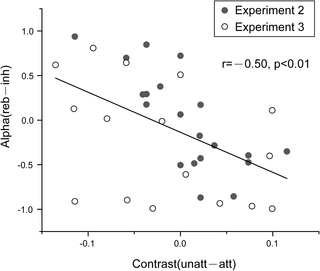PLOS Biology ( IF 7.8 ) Pub Date : 2017-06-28 , DOI: 10.1371/journal.pbio.2001903 Jianrong Jia , Ling Liu , Fang Fang , Huan Luo

|
In a crowded visual scene, attention must be distributed efficiently and flexibly over time and space to accommodate different contexts. It is well established that selective attention enhances the corresponding neural responses, presumably implying that attention would persistently dwell on the task-relevant item. Meanwhile, recent studies, mostly in divided attentional contexts, suggest that attention does not remain stationary but samples objects alternately over time, suggesting a rhythmic view of attention. However, it remains unknown whether the dynamic mechanism essentially mediates attentional processes at a general level. Importantly, there is also a complete lack of direct neural evidence reflecting whether and how the brain rhythmically samples multiple visual objects during stimulus processing. To address these issues, in this study, we employed electroencephalography (EEG) and a temporal response function (TRF) approach, which can dissociate responses that exclusively represent a single object from the overall neuronal activity, to examine the spatiotemporal characteristics of attention in various attentional contexts. First, attention, which is characterized by inhibitory alpha-band (approximately 10 Hz) activity in TRFs, switches between attended and unattended objects every approximately 200 ms, suggesting a sequential sampling even when attention is required to mostly stay on the attended object. Second, the attentional spatiotemporal pattern is modulated by the task context, such that alpha-mediated switching becomes increasingly prominent as the task requires a more uniform distribution of attention. Finally, the switching pattern correlates with attentional behavioral performance. Our work provides direct neural evidence supporting a generally central role of temporal organization mechanism in attention, such that multiple objects are sequentially sorted according to their priority in attentional contexts. The results suggest that selective attention, in addition to the classically posited attentional “focus,” involves a dynamic mechanism for monitoring all objects outside of the focus. Our findings also suggest that attention implements a space (object)-to-time transformation by acting as a series of concatenating attentional chunks that operate on 1 object at a time.
中文翻译:

在持续关注期间对视觉对象进行顺序采样
在拥挤的视觉场景中,必须在时间和空间上高效灵活地分配注意力,以适应不同的环境。公认的是,选择性注意会增强相应的神经反应,推测暗示该注意会持续停留在与任务相关的项目上。同时,最近的研究主要是在注意力分散的背景下进行的研究表明,注意力并不是保持静止的,而是随着时间的推移交替采样对象,这表明对注意力的节奏感很强。然而,目前尚不清楚动力学机制是否实质上在一般水平上介导了注意力过程。重要的是,还完全缺乏直接的神经证据来反映大脑在刺激过程中是否以及如何有节奏地对多个视觉对象进行采样。为了解决这些问题,在本研究中,我们采用脑电图(EEG)和时间响应函数(TRF)方法,可以从整个神经元活动中分离出仅代表单个对象的响应,以检查各种注意环境中注意的时空特征。首先,注意力以TRF中的抑制性α波段(约10 Hz)活动为特征,每大约200毫秒在关注对象和无人照管对象之间切换一次,这表明即使需要注意将大部分时间留在关注对象上也要进行顺序采样。其次,注意力时空模式是由任务上下文所调节的,因此随着任务要求注意力的分布更加均匀,alpha介导的切换变得越来越突出。最后,切换模式与注意力行为表现相关。我们的工作提供了直接的神经证据,以支持时间组织机制在注意力中通常发挥的核心作用,从而使多个对象根据它们在注意力上下文中的优先顺序进行排序。结果表明,除了经典定位的注意力“焦点”之外,选择性注意还涉及一种动态机制,用于监视焦点之外的所有对象。我们的发现还表明,注意力通过充当一系列同时作用于一个对象的注意力块来实现时空(对象)到时间的转换。这样,多个对象就可以根据其在关注上下文中的优先级顺序进行排序。结果表明,除了经典定位的注意力“焦点”之外,选择性注意还涉及一种动态机制,用于监视焦点之外的所有对象。我们的发现还表明,注意力通过充当一系列同时作用于一个对象的注意力块来实现时空(对象)到时间的转换。这样,多个对象就可以根据其在关注上下文中的优先级顺序进行排序。结果表明,除了经典定位的注意力“焦点”之外,选择性注意还涉及一种动态机制,用于监视焦点之外的所有对象。我们的发现还表明,注意力通过充当一系列同时作用于一个对象的注意力块来实现时空(对象)到时间的转换。









































 京公网安备 11010802027423号
京公网安备 11010802027423号